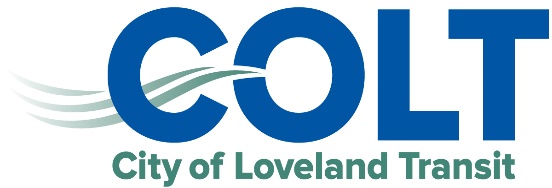
Zero Fare for Better Air, We’ll Get You There is a collaborative, statewide initiative designed to reduce ground-level ozone by increasing transit use. As of August 1, the City of Loveland Transit (COLT) is encouraging community residents and visitors to ride transit to help keep Colorado’s air clean during the summer when air pollution is at its highest. COLT will join the statewide effort to promote public transit during August. The action is made possible by Colorado Senate Bill 22-180, the Ozone Season Transit Grant Program, in partnership with the Colorado Energy Office.
COLT welcomes individuals who may have never used Loveland’s transit services and regular transit users to ride all summer long and save money getting where they need to go.
“The pilot program that launched in August of last year was highly successful. Transit systems from all over the state participated, ranging from those serving the largest cities like RTD in Denver to regional rural systems like SMART in San Miguel County (Telluride region). Mid-size cities throughout Colorado, like Greeley, Pueblo, and Colorado Springs participated in the program. Smaller communities in mountain towns, the eastern plains and western slope also took advantage of this amazing opportunity,” Colorado Association of Transit Agencies (CASTA) Executive Director Ann Rajewski said. “All agencies that participated increased ridership—ranging anywhere between 2% to 59%. This year we are expanding the program for the entire summer and are expecting to increase the number of transit agencies participating.”
“Last year COLT saw a 33% increase in ridership during the Zero Fare for Better Air campaign and looks to beat last year’s numbers with more community participation,” said City of Loveland Transit Manager Candice Folkers. “We encourage residents to take advantage of free fare this August and try public transit to get to work, school, or just to go to a movie. Elimination of even a single car on Loveland roads helps reduce emissions into the air and cuts down on road congestion.”
Approximately 85% of the greenhouse gas emissions from transportation are due to day-to-day commutes. By leaving the car at home, a person can save up to 20 pounds of carbon dioxide emissions every day, depending on the length of the trip. 1
Additional customer benefits of the Zero Fare program are substantial. Riders experience environmental, financial, lifestyle, and community benefits of transit that include:
Cost savings
Taking the bus saves on car expenses, including maintenance and parking, which add up quickly. Not only do you save money on gas, but you also reduce the wear and tear on your vehicle. According to a recent study by AAA, a new car’s routine maintenance and repairs could cost an average of $0.09 per mile. If you drive 10,000 miles in a year, that totals $900. If you drive 20,000 miles, that figure jumps to $1,800 annually. 2
Gas savings
Riding public transit frees up additional funds in customers’ everyday budgets. In addition, public transportation saves the United States an estimated 4.2 billion gallons of gas annually, reducing our dependency on foreign oil. 3
Reduction in traffic
Public transit keeps cars off the road, limiting traffic congestion, air pollution, and ground-level ozone. Colorado’s population grew 39% over the past 20 years and is expected to grow another 30% in the next 20, significantly increasing traffic around the state. This robust growth makes it essential for commuters to have public transit options to offset the increase in traffic and increased distances to work.3
Reduction in stress and increased safety
Taking public transit removes the stress and anxiety of battling everyday traffic. Public transportation is one of the safest ways to travel, and it is ten times safer per mile than traveling by car.4
Increased productivity
While taking public transit, customers can catch up on reading, emails, and podcasts or sit back and relax.
Improved air quality
Transportation is a major source of greenhouse gas emissions causing climate change. Using public transit creates 84% less carbon emissions than driving a car. That is a savings of 63 million metric tons annually. 5
COLT is designed to increase mobility options for residents in Loveland. By joining the statewide Zero Fare campaign this summer, COLT hopes to entice new riders to experience cost savings, stress reduction, a safer ride, and increased productivity while helping get cars off the road and improving Colorado’s air quality. Zero Fare for Better Air. We’ll Get You There!
COLT offers six-fixed routes Monday through Friday from 6:38 a.m. to 7:48 p.m. and 8:48 a.m. to 5:48 p.m. on Saturday. The City of Loveland serves approximately 90,000 rides to Lovelanders annually, including youth and paratransit riders. By the end of 2023, COLT will have a designated Transit Center to allow easy access for COLT and FLEX buses to accommodate riders. The location will also house a Park-n-Ride and a satellite location for Loveland Police Department.
For more information, visit lovgov.org/COLT.
Support Northern Colorado Journalism
Show your support for North Forty News by helping us produce more content. It's a kind and simple gesture that will help us continue to bring more content to you.
BONUS - Donors get a link in their receipt to sign up for our once-per-week instant text messaging alert. Get your e-copy of North Forty News the moment it is released!
Click to Donate
